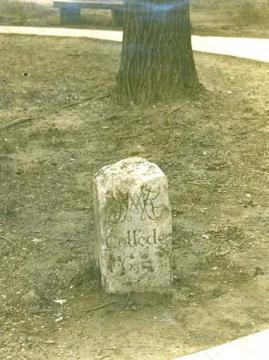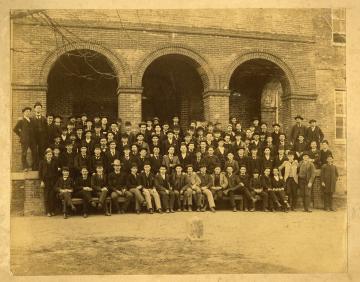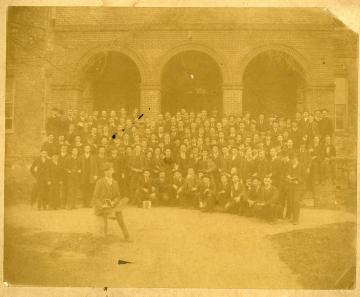
Two 17th century boundary stones erected to mark the property of William & Mary survive. One of the stones can be seen in a display case located on the first floor of Swem Library, near the Lemonade mural.
For the William & Mary site a tract of 330 acres was purchased for £170 from Captain Thomas Ballard on December 20, 1693.
According to a letter from former William & Mary President Lyon G. Tyler to Harold R. Shurtleff, Director of the Research and Record Department of Perry, Shaw and Hepburn Architects, dated February 22, 1933, when Tyler came to the College "one of them [the boundary stones], if I remember rightly, was lying flat on the ground near the President's house; another was before the front door of the Bright house, on the hill. I purchased fifteen acres from Captain Bright and got him to donate the stones to the College, whereupon I placed them in front of the College porch, one on each side of the path leading to the gate." Prior to the restoration of the Wren Building, the stones were stored in its basement. According to a letter dated March 7, 1933, from V. M. Geddy to Mr. Chorley, Harold R. Shurtleff "says frankly that they have no idea where these stones should be located." One of the boundary stones can be seen in front of the Wren Building in a photograph of the 1890-1891 student body (which includes grammar school students). In a photograph of the 1889-1890, a student is seen sitting on it.


A letter from Harold R. Shurtleff to the Williamsburg Holding Corporation dated March 3, 1933, relates that Arthur Shurcliff "has also suggested the interesting idea that a new stone, which might be a replica of one of these old stones, might be placed on the site where the so-called "mere" stone (later called "College boundary stone") was placed in the early 18th century. This stone, though called "College boundary stone", was not actually on College property, but was constantly used as a reference point in describing the boundaries of the College land. Since it was not on College land, it would scarcely have been one of the stones that are now in the old high school, since they have the initials of the College on them."
Two of the boundary stones, erected to mark the property, are part of the University Archives Artifact Collection. From September through November 4, 2007, one of the boundary stones was on exhibit (seen on flickr)at the Muscarelle Museum of Art.
References
- "Buildings and Grounds--Boundary Stones," University Archives Subject File Collection, Special Collections Research Center, Earl Gregg Swem Library, William & Mary.
